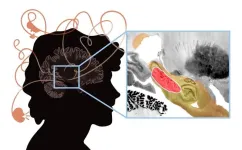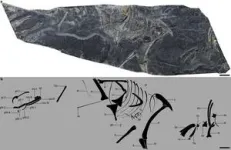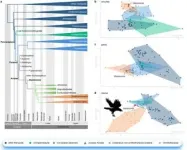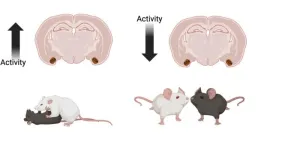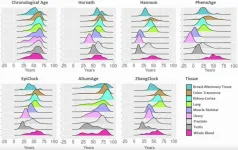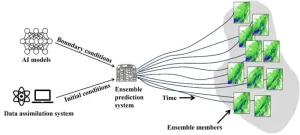(Press-News.org) Andrew Pines, MD, MA, a resident in the Department of Psychiatry at Brigham and Women’s Hospital and a researcher in the Center for Brain Circuit Therapeutics, is the lead author of a paper published in JAMA Psychiatry, Mapping Lesions That Cause Psychosis to a Human Brain Circuit and Proposed Stimulation Target.
Shan Siddiqi, MD, Assistant Professor of Psychiatry at Harvard Medical School and Director of Psychiatric Neuromodulation Research at the BWH Center for Brain Circuit Therapeutics, is the senior author of this paper.
How would you summarize your study for a lay audience?
Our study investigated the brain circuits involved in psychosis—a condition characterized by delusions, hallucinations, disorganized thinking and detachment from reality. Psychosis is the classic symptom of schizophrenia, a serious mental illness that causes marked disability in otherwise young and healthy patients. We analyzed published cases in which focal brain damage caused psychosis, with the idea that if damaging a brain circuit causes a symptom, then mapping that circuit might tell us about how to treat that symptom.
We discovered that these psychosis-inducing lesions, although located in different parts of the brain, all connected to a common brain circuit. The peak in that circuit was in a brain region called the hippocampus, which is believed to be involved in constructing memory and reality.
This finding suggests that this hippocampal circuit plays a crucial role in causing psychotic symptoms, which could help guide new treatments for conditions like schizophrenia.
What question were you investigating?
Can we localize a circuit in the brain that can be targeted with brain stimulation therapy for schizophrenia? Our group has previously shown that analyzing lesions can identify these targets.
In other words, if damaging a brain circuit causes a symptom, then stimulating the same circuit can relieve the same symptom. Here, we sought to determine if the brain lesions that cause psychosis, despite occurring in different parts of the brain, affect a common circuit.
What methods or approach did you use?
We identified 153 published cases where patients with no prior history of psychotic symptoms developed acute psychosis following a brain lesion. We manually traced each patient’s lesion onto a standard atlas, enabling us to compare them. Then, we mapped the circuits connected to each lesion using the human connectome, a large-scale wiring diagram of the human brain. We then identified which connections were common to lesions that cause psychosis, and distinct from lesions that cause other symptoms. We also validated our results with an independent brain lesion dataset of 181 patients.
What did you find?
We discovered that lesions causing psychosis, regardless of their location in the brain, were functionally connected to a common brain circuit centered in the hippocampus. The most specific region was the posterior aspect of a subfield of the hippocampus called the subiculum.
This finding held true even when we excluded lesions that directly touched the hippocampus, suggesting the symptoms were caused by the disruption of a brain circuit instead of a specific brain region.
An area in the rostromedial prefrontal cortex is highly correlated with this circuit and is a promising target to modulate this circuit with transcranial magnetic stimulation (TMS), a treatment that is highly effective for major depression but has shown mixed success for schizophrenia, potentially because previous trials did not know which circuit to target.
What are the implications?
For decades, studies have implicated the hippocampus in schizophrenia, but it was unclear if this was a cause of the disease, a compensatory process, or an incidental consequence of some other part of the disease process. Our study provides the first systematic evidence for a common brain circuit causally involved in psychosis.
This has important implications for understanding how psychosis develops, as we consider how the disruption of a circuit known to be involved in memory can result in psychotic symptoms.
More importantly, the identification of this circuit provides a promising TMS target. TMS has been shown to be safe with few side effects in patients with schizophrenia, a disorder whose current treatments involve medications that often incompletely resolve symptoms or have intolerable side effects.
What are the next steps?
The next step is to test whether targeting the identified brain circuit through the rostromedial prefrontal cortex can improve symptoms in patients with psychosis. We are now launching a clinical trial to test this target in patients with schizophrenia. For more details about the trial, please visit http://siddiqi.bwh.harvard.edu/clinical-trials/
Authorship: In addition to Pines and Siddiqi, Mass General Brigham authors include: Garance M. Meyer, Calvin Howard, Frederic L.W.V.J. Schaper, Michael A. Ferguson, Ari D. Kappel, Clemens Neudorfer, Natalia S. Rost, Lauren L. Sanderson, Joseph J. Taylor, Ona Wu, Isaiah Kletenik, Andreas Horn, Michael D. Fox, and David Silbersweig. Other authors include: Summer B. Frandsen, William Drew, Stephan T. Palm, Christopher Lin, Konstantin Butenko, Maximilian U. Friedrich, Jordan H. Grafman, Jacob W. Vogel, and Alexander L. Cohen.
Paper cited: Pines A R et al “Mapping Lesions That Cause Psychosis to a Human Brain Circuit and Proposed Stimulation Target” JAMA Psychiatry doi:10.1001/jamapsychiatry.2024.4534
Funding: There was no funding for this study, and no funding entity or sponsor had a role in the no role in the design and conduct of the study; collection, management, analysis, and interpretation of the data; preparation, review, or approval of the manuscript; and decision to submit the manuscript for publication
Disclosures: MDF has served as a scientific consultant for Magnus Medical and is owner of intellectual property involving the use of functional connectivity to target TMS, which was not used in the present study. SS is an owner of intellectual property involving the use of brain connectivity to target TMS; has served as a scientific consultant for Magnus Medical; has received investigator-initiated research funding from Neuronetics and Brainsway; has received speaking fees from Brainsway and Otsuka (for PsychU.org); and is a shareholder in Brainsway (publicly traded) and Magnus Medical (not publicly traded). All other authors declare they have no competing interests. ARP had full access to all the data in the study and takes responsibility for the integrity of the data and the accuracy of the data analysis.
END
Research spotlight: Mapping lesions that cause psychosis to a human brain circuit and proposed stimulation target
Lesions that cause organic psychosis affect a common brain circuit in the hippocampus
2025-02-12
ELSE PRESS RELEASES FROM THIS DATE:
New study identifies brain region that can prevent aggressive social behavior and induce pro social behavior
2025-02-12
**MEDIA ADVISORY**
UNDER EMBARGO UNTIL: Wednesday, February 12 at 11am EST
Nature article entitled:
A critical role for the cortical amygdala in shaping social encounters
[https://doi.org/10.1038/s41586-024-08540-4]
Bottom Line: Neural activity in the cortical amygdala determines whether mice engage in aggressive or pro-social behavior
Results: By performing a network analysis on whole-brain activity of male mice, we identified the cortical amygdala – an olfactory cortical structure – as a key brain region in promoting aggression. This brain region is activated by olfactory cues from male mice and by aggressive ...
Telehealth may be closing the care gap for people with substance use disorder in rural areas
2025-02-12
Recognition of telehealth as an effective strategy for delivering treatment for substance use disorder (SUD) has raised hopes for improving access to this treatment in settings with limited transportation or when time constraints compromise regular use of consistent access to in-person substance use treatment.
But the findings from a team of researchers from the Virginia Center for Health Innovation, UCLA, RAND, and MedInsight, Milliman Inc., suggest that the promise of telehealth may vary by insurance and geography.
New research suggests that people who live ...
Stronger, safer, smarter: pioneering Zinc-based dissolvable implants for bone repair
2025-02-12
Monash research could transform how broken bones are treated, with the development of a special zinc-based dissolvable material that could replace the metal plates and screws typically used to hold fractured bones together.
Surgeons routinely use stainless steel or titanium, which stay in the body forever, can cause discomfort and may require follow-up surgeries. A new zinc alloy, designed by Monash biomedical engineers, could solve these problems by being mechanically strong but gentle enough to degrade safely over time while supporting optimal healing.
A study published today in Nature shows the research team’s innovative ...
Could peripheral neuropathy be stopped before it starts?
2025-02-12
An increase in high-fat, high-fructose foods in people’s diets has contributed to a dramatic increase in type 2 diabetes. This, in turn, has led to an increase in peripheral neuropathy — nerve damage, typically in the hands and feet — that causes weakness, loss of sensation and, in some, a stabbing, burning, or tingling pain. About half of people with type 2 diabetes are affected, and of these, about half experience severe neuropathic pain.
The damage begins as axons from sensory neurons begin to retract and disappear from the tissues they innervate. New research from the lab of Clifford Woolf, MB, BCh, PhD, director ...
China Jurassic fossil discovery sheds light on bird origin
2025-02-12
A research team led by Professor WANG Min from the Institute of Vertebrate Paleontology and Paleoanthropology (IVPP) of the Chinese Academy of Sciences has discovered two bird fossils in Jurassic-era rocks from Fujian Province in southeast China. These rocks date back approximately 149 million years. The fossils fill a spatiotemporal gap in the early evolutionary history of birds and provide the evidence yet that birds were diversified by the end of the Jurassic period.
This study was published in Nature.
Birds ...
Long-term yogurt consumption tied to decreased incidence of certain types of colorectal cancer
2025-02-12
Yogurt, which contains live strains of bacteria, is thought to protect against many types of diseases, with some reports indicating it could reduce risk of colorectal cancer. A new study led by investigators from Mass General Brigham finds that yogurt consumption over time may protect against colorectal cancer through changes in the gut microbiome. Using data from studies that have followed participants for decades, researchers found that long-term consumption of two or more servings per week of yogurt was tied to lower rates of proximal colorectal cancer positive ...
Ovarian cancer discovery could turn failed treatment into lifesaver
2025-02-12
University of Virginia Cancer Center researchers have explained the failure of immune checkpoint therapy for ovarian cancer by discovering how gut bacteria interfere with the treatment. Doctors may be able to use the findings to overcome this treatment failure and save the lives of thousands of women every year.
The new discovery, from the lab of UVA’s Melanie Rutkowski, PhD, speaks to the surprising ways that the microbiome – the collection of organisms that live on and inside our bodies – is vital not only to ...
DNA methylation clocks may require tissue-specific adjustments for accurate aging estimates
2025-02-12
“Our results suggest that forensic applications of DNAm clocks using non-blood tissue types will provide age estimates that are not as accurate as predictions based on blood, especially if using clocks algorithms trained on blood samples.”
BUFFALO, NY—February 12, 2025 — A new research paper was published in Aging (Aging-US) on January 3, 2025, in Volume 17, Issue 1, titled “Characterization of DNA methylation clock algorithms applied to diverse tissue types.”
Researchers ...
Tidal energy measurements help SwRI scientists understand Titan’s composition, orbital history
2025-02-12
SAN ANTONIO — February 12, 2025 —Southwest Research Institute (SwRI) scientists are studying Saturn’s moon Titan to assess its tidal dissipation rate, the energy lost as it orbits the ringed planet with its massive gravitational force. Understanding tidal dissipation helps scientists infer many other things about Titan, such as the makeup of its inner core and its orbital history.
“When most people think of tides they think of the movement of the oceans, in and out, with the passage of the Moon overhead, said Dr. Brynna Downey. “But that is just because water moves ...
Data-driven networks influence convective-scale ensemble weather forecasts
2025-02-12
To effectively present the uncertainty of convective-scale weather forecasts, convective-scale ensemble prediction systems have been developed at major operational centers, whose lateral boundary conditions are usually provided by global numerical weather models. Recently, the emergence of AI weather models has provided a new approach to driving convective-scale ensemble prediction systems. AI weather models can produce forecasts for the next 7 to 10 days in just a few minutes, which is around 10,000 times faster than numerical weather models. However, the performance of using the ...
LAST 30 PRESS RELEASES:
Scalable and healable gradient textiles for multi‑scenario radiative cooling via bicomponent blow spinning
Research shows informed traders never let a good climate crisis go to waste
Intelligent XGBoost framework enhances asphalt pavement skid resistance assessment
Dual-function biomaterials for postoperative osteosarcoma: Tumor suppression and bone regeneration
New framework reveals where transport emissions concentrate in Singapore
NTP-enhanced lattice oxygen activation in Ce-Co catalysts for low-temperature soot combustion
Synergistic interface engineering in Cu-Zn-Ce catalysts for efficient CO2 hydrogenation to methanol
COVID-19 leaves a lasting mark on the human brain
Scientists use ultrasound to soften and treat cancer tumors without damaging healthy tissue
Community swimming program for Black youth boosts skills, sense of belonging, study finds
Specific depressive symptoms in midlife linked to increased dementia risk
An ‘illuminating’ design sheds light on cholesterol
Who is more likely to get long COVID?
Study showcases resilience and rapid growth of “living rocks”
Naval Research Lab diver earns Office of Naval Research 2025 Sailor of the Year
New Mayo-led study establishes practical definition for rapidly progressive dementia
Fossil fuel industry’s “climate false solutions” reinforce its power and aggravate environmental injustice
Researchers reveal bias in a widely used measure of algorithm performance
Alcohol causes cancer. A study from IOCB Prague confirms damage to DNA and shows how cells defend against it
Hidden viruses in wastewater treatment may shape public health risks, study finds
Unlock the power of nature: how biomass can transform climate mitigation
Biochar reshapes hidden soil microbes that capture carbon dioxide in farmland
Reducing saturated fat intake shows mortality benefit, but only in high-risk individuals
Manta rays create mobile ecosystems, study finds
Study: Mixed results in using lipoic acid to treat progressive multiple sclerosis
Norbert Holtkamp appointed director of Fermi National Accelerator Laboratory
New agentic AI platform accelerates advanced optics design
Biologists discover neurons use physical signals — not electricity — to stabilize communication
Researchers discover that a hormone can access the brain by hitchhiking
University of Oklahoma researcher awarded funding to pursue AI-powered material design
[Press-News.org] Research spotlight: Mapping lesions that cause psychosis to a human brain circuit and proposed stimulation targetLesions that cause organic psychosis affect a common brain circuit in the hippocampus
